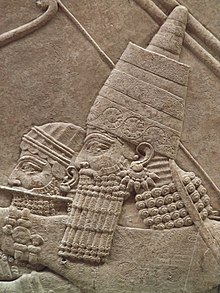
Back Assurbanipal Afrikaans አስናፈር Amharic آشوربانيبال Arabic ܐܫܘܪܒܢܝܦܠ ARC اشوربانيبال ARZ Aşşurbanipal Azerbaijani آشوربانیپال AZB Ашурбаніпал Byelorussian Ашурбанипал Bulgarian অশ্শুর্বানিঅপ্লি Bengali/Bangla
| Ashurbanipal | |
|---|---|
 Ashurbanipal, closeup from the Lion Hunt of Ashurbanipal | |
| King of the Neo-Assyrian Empire | |
| Reign | 669–631 BC[1][2][3] |
| Predecessor | Esarhaddon |
| Successor | Ashur-etil-ilani |
| Born | c. 685 BC[4] |
| Died | 631 BC[5] (aged c. 54) |
| Spouse | Libbali-sharrat |
| Issue | Ashur-etil-ilani Sinsharishkun Ninurta-sharru-usur |
| Akkadian | Aššur-bāni-apli |
| Dynasty | Sargonid dynasty |
| Father | Esarhaddon |
| Mother | Esharra-hammat (?) |
Ashurbanipal[a] (Neo-Assyrian Akkadian: 𒀸𒋩𒆕𒀀, romanized: Aššur-bāni-apli,[10][b] meaning "Ashur is the creator of the heir")[3][12] was the king of the Neo-Assyrian Empire from 669 BC to his death in 631. He is generally remembered as the last great king of Assyria.[8][13] Ashurbanipal inherited the throne as the favored heir of his father Esarhaddon; his 38-year reign was among the longest of any Assyrian king.[c] Though sometimes regarded as the apogee of ancient Assyria, his reign also marked the last time Assyrian armies waged war throughout the ancient Near East and the beginning of the end of Assyrian dominion over the region.
Esarhaddon selected Ashurbanipal as heir c. 673. The selection of Ashurbanipal bypassed the elder son Shamash-shum-ukin. Perhaps in order to avoid future rivalry, Esarhaddon designated Shamash-shum-ukin as the heir to Babylonia. The two brothers jointly acceded to their respective thrones after Esarhaddon's death in 669, though Shamash-shum-ukin was relegated to being Ashurbanipal's closely monitored vassal. Much of the early years of Ashurbanipal's reign was spent fighting rebellions in Egypt, which had been conquered by his father. The most extensive campaigns of Ashurbanipal were those directed towards Elam, an ancient enemy of Assyria, and against Shamash-shum-ukin, who gradually began to resent the overbearing control that his younger brother held over him. Elam was defeated in a series of conflicts in 665, 653 and 647–646. Shamash-shum-ukin rebelled in 652 and assembled a coalition of Assyria's enemies but was defeated and died during Ashurbanipal's siege of Babylon in 648. On account of a lack of surviving records, much of Ashurbanipal's late reign is poorly known.
Ashurbanipal is chiefly remembered today for his cultural efforts. A patron of artwork and literature, Ashurbanipal was deeply interested in the ancient literary culture of Mesopotamia. Over the course of his long reign, Ashurbanipal utilized the massive resources at his disposal to construct the Library of Ashurbanipal, a collection of texts and documents of various different genres. Perhaps comprising over 100,000 texts at its height, the Library of Ashurbanipal was not surpassed until the construction of the Library of Alexandria, several centuries later. The more than 30,000 cuneiform texts that have survived from the library are a highly important source on ancient Mesopotamian language, religion, literature and science. Artwork produced under Ashurbanipal was innovative in style and motifs and is regarded to possess an "epic quality" otherwise absent from much of the art produced under previous kings.
Ashurbanipal is recognized as one of the most brutal Assyrian kings; he was one of the few rulers to boast of his gory massacres of rebellious civilians. His extensive destruction of Elam is regarded by some scholars as a genocide. The Assyrians won many battles under Ashurbanipal, campaigning further from the Assyrian heartland than ever before, but several of his campaigns achieved little strategic advantage. Ashurbanipal failed to maintain control of Egypt, and his wars in Arabia cost time and resources without establishing longterm Assyrian control. His extensive sack of Babylon after defeating Shamash-shum-ukin weakened the resources of the empire and fanned anti-Assyrian sentiment in southern Mesopotamia, perhaps contributing to the rise of the Neo-Babylonian Empire five years after Ashurbanipal's death. Whether Ashurbanipal's policies led to the fall of the Assyrian Empire only two decades after his death is disputed in modern Assyriology.
A distorted legend of Ashurbanipal was remembered in Greco-Roman literary tradition under the name Sardanapalus, purportedly the effeminate and decadent last king of Assyria whose vices led to the fall of his empire.
- ^ Lipschits 2005, p. 13.
- ^ Na'aman 1991, p. 243.
- ^ a b Brereton 2018, p. 10.
- ^ Finkel 2013, p. 123.
- ^ Ahmed 2018, p. 8.
- ^ Cline & Graham 2011, p. 41.
- ^ Scurlock 2013, p. 155.
- ^ a b Chaliand 2014, p. 52.
- ^ Russell 1991, p. 137.
- ^ Hurowitz 2010, p. 96.
- ^ Quentin 1895, p. 554.
- ^ Tetlow 2004, p. 231.
- ^ Frahm 2017, p. 189.
Cite error: There are <ref group=lower-alpha> tags or {{efn}} templates on this page, but the references will not show without a {{reflist|group=lower-alpha}} template or {{notelist}} template (see the help page).
© MMXXIII Rich X Search. We shall prevail. All rights reserved. Rich X Search